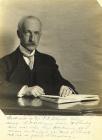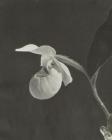28
"Portrait of Dr. F. T. Shutt taken with L'Artistique lens. Dr. Shutt did not like this portrait so I never exhibited it. But I think it is a good likeness."Most of Macnamara's portraits were informal studies of women and children.
30
Many of Macnamara's photographs feature the trees and paths that marked his way through the woods from Arnprior to Marshall's Bay. "The Elms" was also known as "Banning House".32
"Cows at Stream" has the extremely soft focus that critics of pictorialism marked as an attempt to simply blur the lines between photography and art.34
"Juniper Bush" is another example of Macnamara's use of asymmetry in a modern interpretation of the landscape.36
Charles Macnamara as president of the Photography Art Club of Ottawa in 1911, organized its annual exhibition. He exhibited 12 prints that year. In 1913, he exhibited 18 prints including his first scientific entry at the Royal Photographic Society in London, England.38
Taken in 1913, "The Intruder" is Macnamara's most famous portrait. It was exhibited in Ottawa and England in 1913 and Montreal in 1914. This photograph of Jean Macnamara was published in The Amateur Photographer and Photographic News in August 1913 along with praise from critic Anthony Guest:"Credit is due to Mr. C. Macnamara for an extremely simple and suggestive scheme...that gives interest to an almost empty space, with the small head of a child as the point of interest near the centre. There are just the lightly suggested lines of the door...imagination fills up the blanks and a little domestic comedy is realised, if not seen".
40
Charles Macnamara used photography to explore and chronicle the natural world around him. He took thousands of photographs of flowers, animals, tracks, plants, rock formations and birds in addition to his landscape and pictorial images. Occasionally, he made technical notes regarding his photography:"Probably because it was growing in a rather shady place, the colors of this group were rather pale. The lips lacked the rich magenta-crimson of the best specimens. And although I used a Soft Gradation Pan plate, the negative came out too hard; the foliage is too dark and the flowers too light. I must try it again next year at an earlier date, give plenty of exposure and develop softly".






